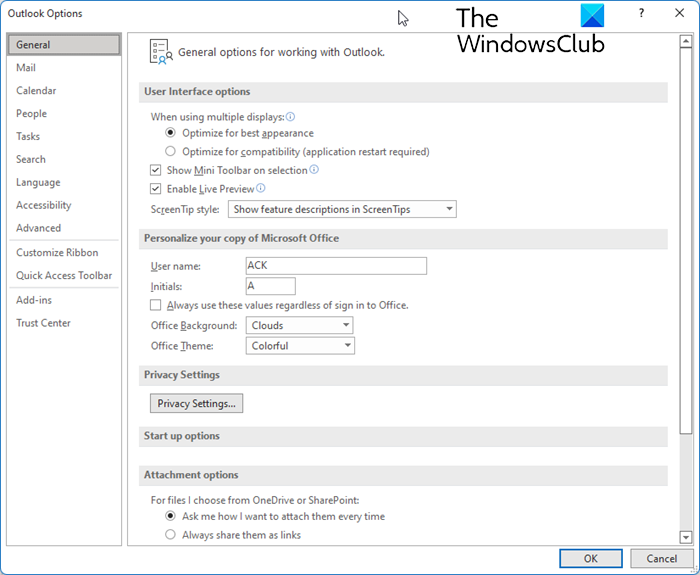Today, I will give you some tips on how to customize Microsoft Outlook. Different people have different needs, and they can customize Microsoft Outlook accordingly. There are plenty of options available with Microsoft Outlook under the File menu that you can use to customize your copy of Outlook as you wish.
How to customize Outlook

From the many features available under File > Options, here is a list of some configuration options that I always use.
Enable Live Preview in Outlook
Available under General, turning on this option lets you view how your email will appear when you hover over different formatting styles. This helps you preview in real time before you actually apply the formatting to the selection. Enabling the option saves you plenty of time. The option is selected by default.
Read: How to reset Outlook view to default
Enable Spelling in Outlook
Available under Mail options, enabling Always Check Spelling before Sending helps you check for spellings automatically as soon as you hit the Send button. This helps, especially if you forget to check to spell manually. While you are there, you should also make sure you enable Ignore Original Messages in Reply or Forward. The second option saves you from the additional trouble of going through the mistakes that others made while sending messages to you.
Read: Change these default Outlook settings to boost productivity
Indent Original Messages upon Reply & Forward
You can choose to close original messages upon reply, but that may result in misunderstanding as the recipients may not understand to which message you are replying. The tradition has always been including and indenting the original messages in replies and forwards. While including the original message helps others grab the context, indenting makes it clear as to which part is the original. The default choice is Include Text. Change it to “Include and Indent”.
Read: How to create a custom View in Outlook
Set up Time Zone in Outlook
Setting up a time zone helps you deal better with meetings and other events. It is even better when you specify two different time zones – one for your local time and the other one to check out your clients’ time zones (a reference to clients is for example).
The option to set up time zones is given under the Calendar section of File -> Options. I would also recommend entering a custom name (label) for each time zone you create so that it becomes easier for you to understand the time zone in calendars.
Read: How to Create, Manage & Change Inbox View in Outlook
Auto Add Contacts To Address Book in Outlook
Enabling this option helps in adding contacts to the address book, even if you forget to add them manually. When you enable this option, if you type in a contact name in To, CC, and BCC, and if that contact is not present in your address book, Outlook will add it to your address book. You can later categorize and group it as you want. You will find this feature under Contacts section of File -> Options. The contacts that Microsoft Outlook adds to your address book using this feature will be visible under Suggested Contacts when you are in Contacts View.
Read: How to attach Sticky Note to an Outlook email.
Delay Sending Of Emails in Outlook
The default configuration makes Outlook send emails as soon as you hit Send. This, of course, requires you to be connected to the Internet when you click Send. In some cases, we recall something and wish we had added or not written something in the email that was sent. To get some time before the message actually leaves your outbox, uncheck Send Immediately When Connected under Advanced of File -> Options. This makes sure your message lies in Outbox until it is time for the next auto Send/Receive.
These are just some of the many options for you to customize Microsoft Outlook. Please share the options that you use regularly.
How to change the interface colur..??
Damnnn, its toooooo white and making me blind. Its like high contrast theme of windows, isn’t there a dark interface like Photoshop cs6..??
Outlook gives you three color schemes under File -> Options -> General: Blue, Black or General. I prefer blue as it is easier on eyes compared to any other scheme.
As I get older, it becomes ever more difficult for me to read the fine print on applications like Outlook. Here’s a post on how to Zoom Outlook 2010 text so you can read it more easily: http://living-with-outlook-2010.com/outlook2010tips/2011/01/outlook-how-to-zoom-outlook-2010-for-easier-reading/ It doesn’t zoom everything in the interface, but at least lets you read the text of messages and the like much easier. Enjoy!
Thank you for sharing the link. It will be a help for many.